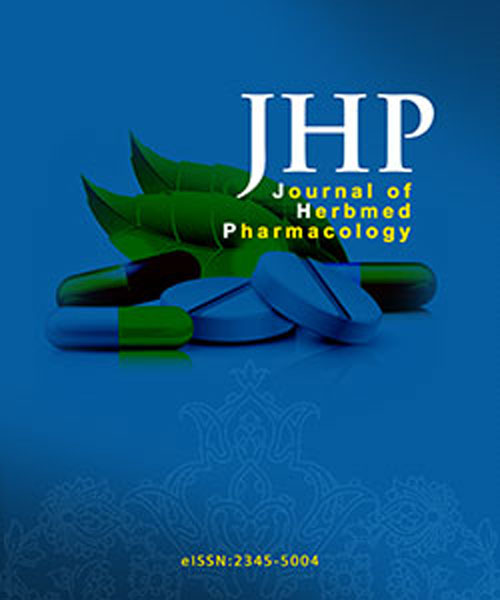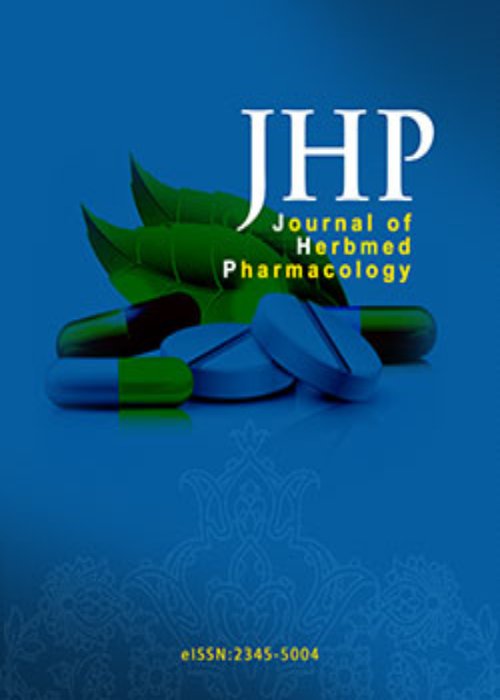فهرست مطالب

Journal of Herbmed Pharmacology
Volume:5 Issue: 2, Apr 2016
- تاریخ انتشار: 1395/02/15
- تعداد عناوین: 8
-
-
Pages 45-49Background And AimsFeverfew (Tanacetum parthenium) is a valuable medicinal plant from Asteraceae family with various pharmacological and therapeutic properties. In this article we reviewed the various aspects of feverfew including botanical characteristics, cultivation and production and medicinal and clinical uses.
Material andMethodsGoogle Scholar, PubMed, EBSCO, Directory of open access journals (DOAJ), EMBASE, and Web of Science were searched using the keywords feverfew and parthenolide.ResultsThe essential oil of feverfew is frequently used in pharmaceutical and cosmetic industries. Parthenolide is the most important active component of feverfew that is used for the treatment of a wide variety of diseases such as fever, migraine headache, and rheumatoid arthritis.ConclusionFeverfew has several positive clinical uses and has the potential to be considered as a new drug for the treatment of some diseases.Keywords: Medicinal plant, Feverfew, Parthenolide -
Pages 50-53IntroductionCancer is a complex genetic ailment and a significant public health disease. Reports have shown that about 30%40% of all cancers can be prevented by lifestyle and dietary procedures alone. This study was aimed to evaluate the anti-proliferative effect of Ananas comosus fruit juice on rapidly proliferating cells.MethodsThe study was carried-out on rapidly proliferating seeds of Sorghum bicolor. Five groups consisting of 20 seeds each were used. Groups 1-2 were the control and methotrexate groups respectively, while groups 3-5 were the test groups treated with different concentrations of A. comosus. The mean lengths (mm) of radicle emerging from the seeds were measured after 24, 48 and 72 hours.ResultThe result showed that the control S. bicolor seeds radicle had a very high growth rate throughout the study. The methotrexate treated seeds showed a significant (PConclusionThe findings from the study indicate that A. comosus fruit juice has an antiproliferative effect.Keywords: Ananas comosus, Pineapple, Antiproliferative potential
-
Pages 54-60IntroductionNowadays, traditional and herbal medicines have attracted the attention of researchers all around the world and despite the development of synthetic drugs, demand for plant-based medicines is growing. The main reason for this growing trend is increasing public concerns about the adverse effects of synthetic medicines. Traditional medicine and ethnobotany are two important issues that should be noted to achieve effective herbal medicines with considerable therapeutic effects. Traditional medicine is based on experience of people over centuries and ethno-botany is based on recognition of the native plants. Iran has very high plant diversity because of its different climate, ecosystems and soil conditions. Regarding increasing demand for medicinal plants, this study aimed to collect some native plant varieties growing in Dastena and to review some of local and folk application of these plants.MethodsIn the present study, the plant species were collected during two consecutive years (2013-2014) and systematically identified. The traditional and local uses of collected plants were questioned through interviews with local people.ResultsIn this study, 90 plant species belonging to 30 families were collected and identified. They had various therapeutic effects. Lamiaceae and Asteraceae families had the highest use among the collected plants.ConclusionResults of this study showed that herbal medicines in this area are mostly used to treat digestive and respiratory system disorders. They have economical values and should be studied and explored more detailed.Keywords: Herbs, Traditional uses, Ethnobotany, Iran
-
Pages 61-66IntroductionQuercetin is an effective compound which is found in many medicinal plants. Quercetin antioxidant properties against cancerous tumors and apoptosis induction have been demonstrated. This study is aimed to investigate the molecular dynamics of quercetin with regard to activating the pre-apoptotic factors such as Bim, Bak, and Bad using simulation software.MethodsIn this study, the thermodynamic properties of flavonoid molecule of quercetin on three important factors in apoptotic pathway such as Bim, Bak, and Bad were investigated. After the three-dimensional structure of these molecules was obtained from NCBI and simulation was done by Gromacs software, docking stages were performed by AutoDock software and then the molecular dynamics of the complexes were investigated by Gromacs software.ResultsThe number of hydrogen bonds between quercetin and Bad was higher than Bak and Bim, which causes Bad to have lower energy than Bak and Bim. Mean root-mean-square deviation at 10 ns of simulation increased for Bad and Bak and decreased for Bim in quercetin presence. Root-mean-square fluctuation investigations indicated that Bim had the highest flexibility in quercetin presence compared to free state.ConclusionComputational studies indicated that quercetin could have a greater effect on Bad compared to Bak and Bim. However it is necessary to investigate the effect mechanism of quercetin on these three pre-apoptotic factors in experimental studies.Keywords: Apoptosis, Molecular dynamic, Phytochemistry, Quercetin
-
Pages 67-71IntroductionPrevious studies have shown anti-ulcerogenic effects of Artemisia sieberi (A. sieberi) on gastric lesions and experimental skin wound, so this study was conducted to evaluate healing effects of A. sieberi on the experimental second degree burn in mice skin.MethodsNinety adult male mice in 3 groups were used. Second degree burn was made in the dorsum and then silver sulfadiazine (SSD) 1% ointment and A. sieberi extract were applied in the positive control and treatment groups respectively, while in the negative control no medication was done. Digital photographs were taken daily for determination of healing percentage. For histopathological assessment, 5 mice of each group on the days 1, 3, 7, 14 & 21 post burn, were chosen and after euthanasia, a full thickness skin flap of the burn was taken and after tissue processing, specimens were stained with Hematoxylin-Eosin (H&E) and examined for granulation tissue, inflammation, re-epithelialization and collagen sediment, also hydroxyproline content of burn was measured. Data were presented as mean ± SE and analyzed by using Kruskal-Wallis and Dunn post huc tests (P ≤ 0.05).ResultsA. sieberi enhanced wound healing via significantly decreased inflammation, increased granulation tissue, hydroxyproline content and healing percentage in comparison to negative control in such a manner which was comparable to standard SSD.ConclusionIt seems that A. sieberi can promote burn healing due to anti-inflammatory, antioxidant, anti-microbial and mitogenic properties of the plant.Keywords: Aremisia sieberi, Second degree burn, Healing
-
Pages 72-77IntroductionFrom a consumer perspective, developing a hair care formulation that offers multi-purpose products to enhance routine hair care such as conditioning, cleaning and grooming hair and stimulating hair follicles is important. Eugenol comprising about 70% of clove essential oil shows an androgenic activity and stimulates hair root to feed and hence could be a good candidate for developing an anti-hair loss formulation. Thus in hair research, hair follicle is of great interest. The aim of this study was to develop a self-emulsifying product containing eugenol in emu oil as a carrier.MethodsEugenol was identified in clove oil extraction by UV spectrophotometer. Emu oil was characterized according to national oil standards. All formulations were prepared and best one was selected for further pharmaceutical examinations such as pH, particle size, content uniformity and drug release. The optimum formulation was clinically evaluated on rats back compared with minoxidil standard lotion as a positive control and distilled water as a negative control.ResultsThe selected formulation was demonstrated to condition hair with grooming and enhanced hair growth with longer lag time compared with minoxidil but after one week the hair growth accelerated.ConclusionThe formulation containing clove oil in emu oil self-emulsion shows a conditioning and grooming property with hair shaft repair and hair growth.Keywords: Hair loss, Eugenol, Emu oil, Conditioner
-
Pages 78-84IntroductionCandida glabrata is a yeast fungus regularly isolated from patients with impaired immunity who receive a routine antifungal therapy. Drug-resistant strains of C. glabrata have been emerged in recent years. The aim of this study was to examine the therapeutic efficacy Origanum vulgare essential oil (OVEO) against drug-resistant strains of C. glabrata and its cytotoxic effect on macrophages.MethodsSpecimens were collected from mucosal surfaces of the oral cavity of medically approved oropharyngeal candidiasis (OPC) in HIV-positive patients and volunteered healthy individuals using sterile swabs or mouthwashes. In vitro antifungal susceptibility testing was done using microdilution and disc diffusion methods. Chemical composition of OVEO was determined using gas chromatography mass spectrometry. The cytotoxic effect of essential oil on macrophages was examined using tetrazolium dye (MTT).ResultsMinimum inhibitory concentration (MIC) range of OVEO in healthy individuals and OPC patients was 150-200 and 150-250 μg/mL, respectively. OVEO efficiently inhibited growth of resistant isolates. In isolates obtained from HIV patients, both MIC50 and MIC90 of OVEO were 200 μg/mL while in healthy individuals were 150 and 200 μg/mL, respectively. Moreover, OVEO induced significant reduction in proliferation of murine RAW264.7 and peritoneal macrophages in concentrations higher than 100 and 300 μg/mL, respectively. Main constituents of OVEO were thymol (27.3%), γ-terpinene (20.7%) and carvacrol (16.1%).ConclusionOVEO could be used as a fungicidal agent against fungal infections caused by azole-resistant C. glabrata. A combination therapy along with standard antifungals is suggested to avoid its cytotoxic effects.Keywords: Origanum vulgare, Essential oil, Candida glabrata, Antifungal, Oropharyngeal candidiasis
-
Pages 85-88IntroductionButea frondosa has been suggested to be very useful in treating inflammatory diseases but no scientific investigation has been done in such direction. In this study the anti-inflammatory and anti-microbial activities of leaves aqueous extract of B. frondosa were determined in infected and non-infected human whole blood against specific vaccine antigen, HBsAg.MethodsIn order to explore the anti-inflammatory and anti-microbial activities of B. frondosa (0.50 mg/mL; 50 μl), infected (virally) and non infected (control) human whole blood samples were stimulated with hepatitis B vaccine containing surface antigen (HBsAg, 20 μg/mL;10 μl) in order to determined its blood counts and proliferation assay.ResultsAqueous leaves extract of B. frondosa (10 mg/mL; 50 μl) containing HBsAg inhibited the percentage count of monocytes as well as granulocytes population in both cases. In addition, this aqueous extract also reduced its proliferation rate at higher doses.ConclusionAqueous leaves extract of B. frondosa possesses both anti-inflammatory and antimicrobial activities and might be used for these purposes.Keywords: Butea frondosa_Anti_inflammatory_Anti_microbial_Hepatitis B vaccine


